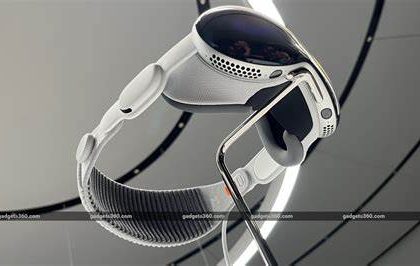
Centre for Accessibility Australia (CFA Australia) Reflects on the Apple Vision Pro.
Since the unveiling of Apple’s Vision Pro headset at its recent launch at the World Wide Developer Conference 2023 (WWDC23) in the heart of Silicon Valley, the tech world has been whirring with a range of reactions.
With words like “dawn of computing” or “the digital future is screenless” floating around everywhere on the interwebs, it’s easy to dismiss them as typical corporate prattle. Except, the more I look into the Vision Pro, the more they seem to ring true.
And with the accessibility features on offer, I’m finding myself open to embracing the glossy, new, ‘Matrix-chic’ design possibilities.
So, the team at CFA Australia have some thoughts.
Quite a lot of thoughts.
But firstly, what is the Apple Vision Pro?
They’re being described as “mixed reality” goggles, that sort of have the look of a cyberpunk aviator of the future. Does that make sense? Picture any sort of late 90s film with a nerdy computer programmer becoming the saviour of the universe (“The blue or the red pill?”) while getting a slick combat boots and sunglasses wardrobe change, along the way. I mean, hey, if we’re heading towards dystopia with the way the world is going, at least we’re getting the aesthetics?
But in short, it’s a new Virtual Reality (VR) experience with high-resolution OLED displays where pixels pop with stunning clarity and colours. Online platforms are already in heated debate, and it hasn’t even been released to the public yet.
What makes this interesting however, is the inclusive technology evident in the features designed to cater to individuals with disability.
Check out what’s on offer.
Enhanced Control Options: One of the standout accessibility features of the Vision Pro headset is the range of control options available. Nicholas Kapirnas, one of our Junior Digital Accessibility Analysts, highlights the potential benefits for users who are blind or have low vision. The headset’s high-resolution OLED displays and the possibility of customizable text size and colour contrast could greatly enhance the experience.
Additionally, the ability to control the headset through eye movements, voice commands, and basic hand gestures offers adaptability for individuals with diverse needs. Apple’s commitment to customization is crucial, as it enables users to tailor their interaction methods to suit their specific abilities.
Accessibility Beyond the Interface: The inclusion of Guided Access, a feature that minimizes distractions and promotes focus, is particularly valuable for users who require a more streamlined and singular experience. By eliminating non-essential elements and suppressing hardware button events, Guided Access allows users to concentrate on their desired app without unnecessary interruptions.
VoiceOver, Apple’s renowned screen reader, further enhances accessibility by providing an option for users to navigate the interface through auditory cues. The integration of VoiceOver as a customizable shortcut ensures quick and easy activation, enabling individuals who are blind or with low vision to engage seamlessly with the headset.
Addressing Challenges and Future Potential: While the Vision Pro headset exhibits impressive accessibility features, there are areas where improvements can be made. One concern highlighted by Nicholas is the headset’s limited battery life, which restricts its usability outside of the home. Apple should consider enhancing the battery capacity to facilitate extended usage and accommodate users on the go.
Moreover, Chris Leighton’s – our Technical Lead – observation about VR-induced motion sickness raises an important point. Apple needs to ensure that the Vision Pro headset offers comfortable and adaptable experiences to alleviate any discomfort for users, particularly during lengthy session times.
Looking ahead, the possibilities for accessibility in VR are vast. Nicholas expresses hope for features such as real-world magnification and text-to-speech capabilities, emphasizing the potential impact these functionalities could have for individuals with accessibility needs. Apple should actively explore and implement such features to unlock the headset’s full accessibility potential.
Cara O’Sullivan, another of our Junior Digital Accessibility Analysts describes how in the past it has been difficult for them to wear VR goggles, as a glasses wearer, but has pointed out that Apple has addressed this issue by partnering with Zeiss (A German optics company) to provide a solution for those in need of prescription lenses.
By offering Zeiss Optical Inserts that can be tailored to individual vision prescriptions, Apple aims to cater to a wider audience. These inserts conveniently attach magnetically to the Vision Pro lenses, ensuring precise viewing and eye tracking capabilities. Although the cost of these Zeiss prescription inserts is yet to be revealed, it’s important to note that Apple will sell vision correction accessories separately.
So, all in all, our thoughts are mixed, but mostly hopeful.
By offering a range of control options, incorporating features like Guided Access and VoiceOver, and considering future advancements, Apple is paving the way for inclusive VR experiences.
As yet there is no date of release, but the talk is sometime in 2024.
Hopefully this will set a precedence for future VR possibilities. And we’ll get to look cool along the way (I’ll pick the red pill, Morpheus).
